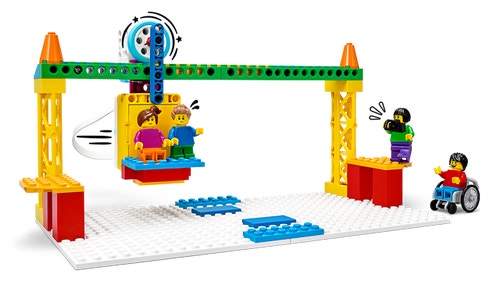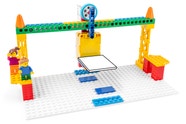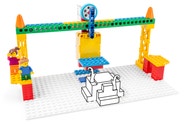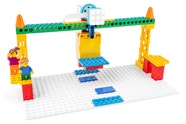Cable Car
Leo is nervous about crossing Spike Lake in the cable car today. Can Maria help him to conquer his fear?

Prepare
- Review the Cable Car lesson in the LEGO® Education SPIKE™ App.
- Consider the abilities and backgrounds of all your pupils. Differentiate the lesson to make it accessible to everyone. Please refer to the Differentiation section below for suggestions on how to do this.
- If time permits, plan and facilitate the language arts extension. Please refer to the Extension section below for further information.
Engage
(Whole Class, 5 Minutes)
- Facilitate a quick discussion about repeating a motion in order to repeat a task.
- Talk with your pupils about moving people from one place to another.
- Ask questions like these: What are some ways of moving people from one place to another? How could that mode of transportation be repeated to make sure that everyone gets to where they want to go?
- Introduce your pupils to the story’s main characters and the first challenge: moving the cable car across the lake.
- Distribute a brick set and a device to each group.
Explore
(Small Groups, 30 Minutes)
- Have your pupils use the LEGO® Education SPIKE™ App to guide them through their first challenge:
- Create and test the program that moves the cable car across the lake.
- Have your pupils iterate and test their models to complete the next two challenges in the app:
- Modify the program to improve the cable car ride.
- Upgrade the cable car for Leo and Maria’s next trip.
- You can find coding and building help in the Tips section below.
Explain
(Whole Class, 5 Minutes)
- Gather your pupils together to reflect on their completed challenges.
- Ask questions like these: How did you improve the program for the cable car ride? Why did you make those improvements?
Elaborate
(Whole Class, 5 Minutes)
- Prompt your pupils to discuss and reflect on how they have used sequences and loops.
- Ask questions like these: How did introducing a loop to your program improve the cable car ride? Why do you think it is valuable to have something on a loop?
- Have your pupils tidy up their workstations.
Evaluate
(Ongoing Throughout the Lesson)
- Ask guiding questions to encourage your pupils to ‘think aloud’ and explain their thought processes and reasoning in the decisions they have made while building and programming their models.
Observation Checklist
- Measure your pupils’ proficiency in using sequences and loops.
- Establish a scale that suits your needs. For example:
- Requires additional support
- Can work independently
- Can teach others
Self-Assessment
Have each pupil choose the brick that they feel best represents their performance.
- Yellow: I think that I can use sequences and loops.
- Blue: I can use sequences and loops.
- Green: I can use sequences and loops, and I can also help a friend to do it.
Peer Feedback
- In their small groups, have your pupils discuss their experiences working together.
- Encourage them to use statements like these:
- I liked it when you…
- I would like to hear more about how you…
Tips
Coding Tips
- After your pupils have completed their first challenge, they will be provided with a map.
- Using the map, your pupils can experiment with the available Coding Blocks to modify their programs to follow the route for the trip.




Model Tip
- After your pupils have completed their second challenge, they will be provided with three Inspiration Images and an open-ended prompt, which will help them to improve their models.
- The Inspiration Images are meant to help spark their imaginations as they experiment and change their models.




There are no specific building instructions for this challenge.
Differentiation
Simplify this lesson by:
- Reading the Cable Car story and instructions from the LEGO® Education SPIKE™ App aloud to your pupils
- Selecting one Inspiration Image to help your pupils to change their models
Increase the difficulty by:
- Exploring new and different coding blocks within the program
- Making the cable car track as long as possible
Extension
- Have your pupils write a story about Leo and Maria’s trip across Spike Lake in the cable car. Tell them to use a clear sequence of events that explains what Leo and Maria did before, during and after their trip.
If facilitated, this will extend beyond the 45-minute lesson.
ACELA1489
Understand differences between the language of opinion and feeling and the language of factual reporting or recording
Teacher Support
The pupils will:
- Use sequences and loops to program their models
- Identify and fix errors a program to ensure that it works as they have intended (test and debug)
- Recount an experience using relevant facts and descriptive details
(one for every two pupils)
- LEGO® Education SPIKE™ Essential Set
- Device with the LEGO® Education SPIKE™ App installed
Design and Technologies
ACTDEK010
Recognise the role of people in design and technologies occupations and explore factors, including sustainability that impact on the design of products, services and environments to meet community needs.
Digital Technologies
ACTDIP011
Implement simple digital solutions as visual programs with algorithms involving branching (decisions) and user input.
English Language
ACELA1489
Understand differences between the language of opinion and feeling and the language of factual reporting or recording.




